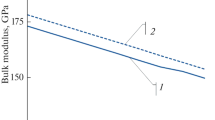Abstract
In this work, the electronic structure and the magnetic state of Fe-Cr, Fe-V, and Fe-Cr-V alloys are investigated by the method of coherent potential in the approximation of Hartree-Fock. The effective fields on the nuclei of Fe of the ternary alloys are calculated using the results that have been obtained. The effective fields on Fe nuclei in Fe-Cr-V alloys have been experimentally measured. Comparison with the experimental results shows that the electronic and magnetic states of both the binary and ternary alloys are reasonably described by the coherent potential method. Analysis of the available results allows one to explain the differences existing in the phase diagrams of binary alloys as well as to reach conclusions about the shape of the equilibrium phase diagram of the ternary alloy.
Similar content being viewed by others
Literature cited
O. Kubashevski, State Diagrams for Iron-Based Binary Systems [in Russian], Metailurgiya, Moscow (1985), pp. 42, 157.
K. V. Chuistov, Aging of Metallic Alloys [in Russian], Naukova Dumka, Kiev (1985).
A. A. Zhukov, Geometric Thermodynamics of Iron Alloys [in Russian], Metallurgiya, Moscow (1979).
M. V. Nevitt, in: Electronic Structure of Transition Metals and Chemistry of Alloys, Metallurgiya [in Russian], Moscow (1966), pp. 97–107.
J. O. Anderson, Calphad,7, No. 4, 305–315 (1983).
A. J. Aldred and B. D. Rainford, Solid State Commun.,34, No. 5, 256–267 (1980).
H. Lutgemeier and S. M. Dubiel, J. Magn. Magn. Mater.,28, No. 3, 277–281 (1982).
J. Mirebeaw and G. Paretty, J. Appl. Phys.,53, No. 3, 1960–1962 (1982).
O. Yamashita and Y. Yamagushi, JAERI Report, No. M7408, 56–57 (1977).
K. P. Gupta and C. H. Chend, Phys. Rad.,23, No. 4, 721–725 (1962).
H. Martens and P. Duwez, Trans. ASM,44, No. 2, 484 (1952).
I. I. Kornilov and N. M. Matveeva, Zh. Neorg. Khim.11, No. 2, 355–366 (1957).
V. S. Demidenko and A. P. Kal'yanov, Izv. Vyssh. Uchebn. Zaved., Fiz., No. 3, 62–76 (1983).
V. S. Demidenko and A. P. Kal'yanov, Method of Coherent Potential in Metal Science [in Russian], Izd. Tomsk State Univ., Tomsk (1984).
S. M. Dubiel and C. C. M. Campbell, Solid State Commun.,26, No. 9, 593–597 (1978).
V. E. Panin and V. S. Demidenko, Reports of 4th All-Union Conference on Atomic Ordering and Its Effect on Alloy Properties [in Russian], Tomsk State Univ., Tomsk (1974), Ch. 1, 32–43.
G. Mima and M. Yamaguchi, Nippon Kinzoku Gakkai-Shi,33, No. 11, 1308–1313 (1969).
Author information
Authors and Affiliations
Additional information
Translated from Izvestiya Vysshikh Uchebnykh Zavedenii, Fizika, No. 12, pp. 77–83, December, 1988.
Rights and permissions
About this article
Cite this article
Vasman, G.I., Kalyanov, A.P. & Demidenko, V.S. Role of electronic structure in the formation of the properties and characteristics of interatomic interaction in alloys of iron with chromium and vanadium. Soviet Physics Journal 31, 1021–1026 (1988). https://doi.org/10.1007/BF01101175
Received:
Issue Date:
DOI: https://doi.org/10.1007/BF01101175



